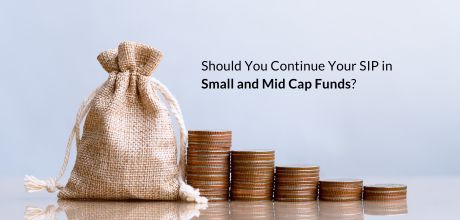How to invest in Mutual Funds During Volatile Markets

Market volatility is inevitable, but understanding equity returns, strategically booking profits, and investing can help you navigate the turbulence. Stay patient, and stay disciplined—your SIPs will reward you in the long run!
AMFI’s “Mutual Fund Sahi Hai” campaign may have drawn thousands of new investors into the fold last year, but volatile equity and debt markets have frustrated them so far. Small and Mid-cap funds have taken a particularly intense drubbing, but large caps haven’t been spared either. However, as an investor, you needn’t worry – Mutual Fund returns are seldom linear in nature, and you’ve got to be prepared for such times. This simple three-point action plan can prove useful in helping you tackle volatile markets.
Understand How They Work
Nearly Rs. 8,000 Crores of retail household savings now flow into Mutual Funds every year through the SIP (Systematic Investment Plan) route, but the overall levels of awareness about the nature of equity returns are still alarmingly low! Most new equity investors still harbour misplaced expectations about the way equity returns work, not realising that their portfolio values even stay in the negative zone for extended time frames, only to deliver handsome returns in the long run. If you feel unsettled at the thought of such non-linear growth, your risk tolerance levels may not be aligned to equity investing at all; and you should either stay away from equity-oriented funds (a poor choice), or just accept how they work and be mentally prepared!
Take Profits Occasionally
Many new age robo advisory platforms have chanted “SIP it, shut it, forget it” for years now, but this may very well not be sound advice at all. This grossly oversimplified formula fails on two accounts. One, it prevents investors from capitalising on profit booking opportunities during times when markets are peaking out and almost crying out “correction ahead!” Two, it disregards the all-important (and very real!) ‘behaviour gap’ associated with equity investing – after all, if an investor panics and stops & redeems his SIP’s when his money slips into the red, what good was that investment in the first place? Instead of just conveniently ‘flowing with it’, work closely with a professional Financial Advisor who can assist you with a disciplined rebalancing of your portfolio on a periodic basis. Once a year, or whenever your portfolio hits an predefined absolute return figure (say 15%) should work just fine.
Stay the Course
Remember the painful bear market of 2008, when stock prices of even good companies more than halved from their peaks? Here’s a fun fact: the investor who ‘accidentally’ forgot to stop his SIP’s between 2008 and 2011, would have been the most richly rewarded! The key lesson here when it comes to Mutual Fund SIP’s (Systematic Investment Plans) is this: when things head south, put on your seatbelt and hang in there – just let your SIP debits take place, even if it’s with your teeth gritted and your eyes closed! In fact, it is those very SIP tranches that create the maximum long-term wealth in the long run – hence, stopping your SIP’s just because “markets are bearish right now”, is the worst move of all. Remember, dispassion is your best friend during bearish phases.
Your Investing Experts
Relevant Articles
How To Select The Best Mutual Funds For Long Term Goals
Mutual funds offer a compelling way to invest for long-term goals, leveraging professional management and diversification to potentially achieve significant returns. But with a vast array of options available, selecting the best mutual funds for the long term can feel daunting. This guide will equip you with the knowledge to confidently navigate the mutual fund landscape and learn how to select the best mutual fund aligned with your long-term aspirations.
Should You Continue Your SIP in Small Cap Mutual Funds
Investing in small cap funds requires patience and discipline, especially during market corrections. By staying committed to your SIPs and focusing on long-term goals, you can leverage the power of rupee cost averaging and compounding. Don’t let short-term market noise dictate your strategy—remain focused, stay the course, and trust that your disciplined approach will yield results over time.
Systematic Withdrawal Plans (SWP): A Reliable Way to Generate Regular Income
An SWP allows investors to withdraw a predetermined amount from their mutual fund investments at regular intervals, such as monthly, quarterly or annually. The beauty of SWPs lies in their flexibility—they provide consistent income while allowing the remaining investment to continue growing.
.png)


_(2).jpg)